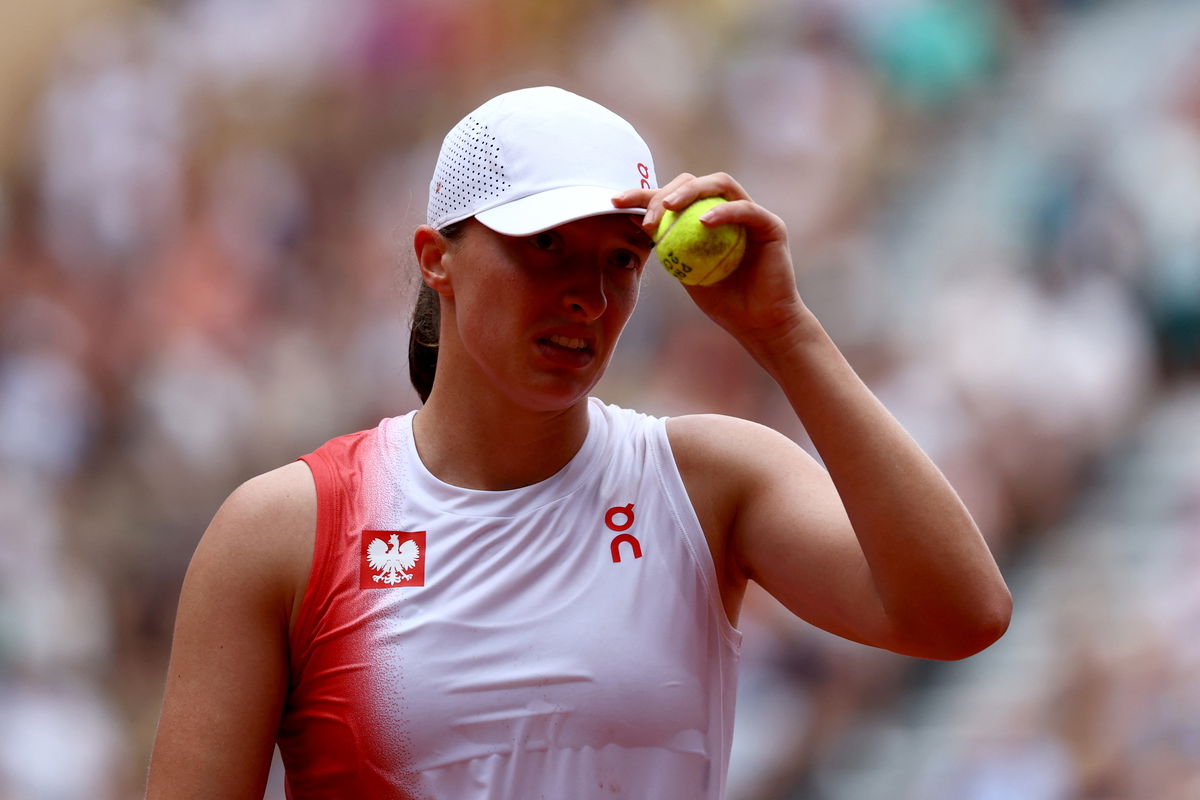
Reuters
Paris 2024 Olympics – Tennis – Women’s Singles Quarterfinals – Roland-Garros Stadium, Paris, France – July 31, 2024. Iga Swiatek of Poland reacts during her match against Danielle Collins of United States. REUTERS/Edgar Su

Reuters
Paris 2024 Olympics – Tennis – Women’s Singles Quarterfinals – Roland-Garros Stadium, Paris, France – July 31, 2024. Iga Swiatek of Poland reacts during her match against Danielle Collins of United States. REUTERS/Edgar Su
“I admit this situation hit me hard because all my life I strived to have a career that could be an example for generations to come,” said Iga Swiatek after accepting the ban amid the latest doping controversy. The WTA star was never really able to provide a rationale behind the sudden break she opted for. While fans assumed that it could be the mental and physical toll she had to face because of the demanding tennis calendar, the reality turned out to be shocking. Amid the hate, a tennis insider recently stepped forward to solve the mystery and develop a rationale.
Watch What’s Trending Now!
Jon Wertheim, a renowned sports journalist, recently shared strong opinions on Andy Roddick’s Served Podcast about Iga Swiatek’s doping case. “The International Tennis Integrity Agency, keep an eye on the word integrity. It does a lot of lifting here. Integrity means the honor and the integrity of competition—no match-fixing, no doping. That’s great, that’s what we all want. But I think there also has to be integrity in doping protocols. And what we have here, for the second time in 100 days, is a top player who had trace amounts of a substance. The facts of the case just don’t align with common sense, they don’t necessarily align with cheating,” the insider said.
Moving the blame solely from the players, he added, “I mean we we saw this with Sinner and to some extent we saw this with Iga as well where she says look I’m taking some time off and I need to relax and recover obviously not revealing the real reason behind this um I don’t blame her at all I mean that is a system that is set up.”
ADVERTISEMENT
“The toughest battle of my life.”
Iga Swiatek’s full statement after accepting a one-month suspension under the Tennis Anti-Doping Programme for testing positive for the prohibited substance trimetazidine. pic.twitter.com/Zya4YmAEqO
— Eurosport (@eurosport) November 28, 2024
The drama began in August 2024 when Swiatek tested positive for trimetazidine (TMZ), a banned heart medication. The 23-year-old took the non-prescription medication melatonin which is manufactured in Poland to deal with jet lag and sleep issues. The International Tennis Integrity Agency (ITIA) later confirmed that the banned substance entered her system through contamination. Swiatek’s level of fault was deemed to be at the lowest end for “No Significant Fault or Negligence.”
Sharing her side on Instagram, Swiatek wrote, “In the last two-and-a-half months I was subject to strict ITIA proceedings, which confirmed my innocence. The only positive doping test in my career, showing unbelievably low level of a banned substance I’ve never heard about before, put everything I’ve worked so hard for my entire life into question. Both me and my team had to deal with tremendous stress and anxiety. Now everything has been carefully explained, and with a clean slate I can go back to what I love most.”
ADVERTISEMENT
Swiatek was provisionally suspended on 12 September and this caused her to miss three tournaments. She appealed the suspension on 22 September after identifying the source of contamination. Independent testing confirmed her explanation, and the ITIA offered her a one-month suspension. Her provisional suspension was lifted on 4 October, and she will officially return on 4 December 2024. However, she was also forced to forfeit the prize money from her Cincinnati Open semi-final run, which directly followed her positive test. But the question is whether the Pole is being given preferential treatment. Well, some think yes.
ADVERTISEMENT
Simona Halep questions ITIA’s fairness amid Iga Swiatek controversy
Simona Halep also voiced her frustration with the International Tennis Integrity Agency (ITIA) after the news of Iga Swiatek’s one-month suspension for a positive doping test broke. The Romanian, who faced her own doping battle, took to Instagram to express her disappointment. Halep called out the ITIA, accusing the organization of unfair treatment and double standards in handling doping cases. She wrote, “I’m sitting and trying to understand, but it’s really impossible for me to understand something like this. I stand and ask myself, why is there such a big difference in treatment and judgment? I can’t find and I don’t think there can be a logical answer. It can only be bad will from ITIA, the organization that has done absolutely everything to destroy me despite the evidence.”
Halep’s doping saga began after she tested positive for Roxadustat at the 2022 US Open. The ITIA handed the former world no. 1 a four-year ban and this somehow ended her career. Halep tried fighting to have her suspension reduced, which allowed her to return earlier this year. Her experience left a lasting mark. Many in the tennis world felt that the ITIA treated her unfairly now that Swiatek’s case has come to light. The reduced suspension for Swiatek has reignited debates about inconsistencies in doping protocols and player treatment.
Top Stories
ATP Forced Into Action After Players Raise Serious On-Court Safety Concerns

Tennis World Grieves After Tragic Incident at Bondi Beach, Australia

Stefanos Tsitsipas Breaks Silence As Family Twist Emerges in Serious Off-Court Drama

Nick Kyrgios’ Australian Open Wildcard Hangs in the Balance as Uncertainty Looms Large

Novak Djokovic Confirms Adelaide Return as Carlos Alcaraz and Jannik Sinner Set for Exhibition

Critics argue that her position as a top-ranked player influenced the ITIA’s decision. Halep’s comments add more weight to these criticisms, as she highlighted the contrasting nature between her long battle and Swiatek’s simple way out. The controversy has also ignited questions about whether the ITIA operates with fairness and transparency.
ADVERTISEMENT
ADVERTISEMENT
ADVERTISEMENT
ADVERTISEMENT

